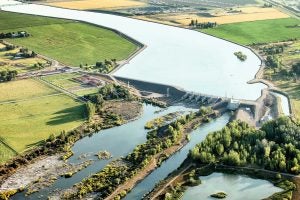“I love that dammed Snake River,” reads the bumper sticker I have displayed for a number of years. Though constantly under threat from environmentalists, supporters of the four lower Snake River dams in Washington state have successfully countered efforts to breach the dams for decades.
Now, during a lull in the battle, an unexpected proposal from a Republican congressman, U.S. Rep. Mike Simpson from Idaho, has thrown a wrench into the machinery. He is proposing to breach the four lower Snake River dams in exchange for a 35-year prohibition on lawsuits against the operation of the remaining dams in the Columbia-Snake River system, plus $33.5 billion to mitigate damages to stakeholders.
There is no guarantee that throwing these four dams under the bus will save the Idaho salmon runs, and when that becomes a reality, the cry to remove more dams will intensify. I don’t want to impugn Simpson’s motives, but I am sure he wants to ensure the survival of the three dams in Idaho’s Hells Canyon — Hells Canyon dam, Oxbow, and Brownlee — that block access to nearly 370 miles of prime salmon habitat.
In total, there is over a dozen dams without fish passage on the Snake River and its tributaries in Idaho.

The four dams on the lower Snake River — Ice Harbor, Lower Monumental, Little Goose, and Lower Granite, built in the 1960s and ’70s — make Lewiston, Idaho, a Pacific Ocean port city. Through this port and other facilities located in the slack water of each dam pass 3.8 million metric tons of mostly agricultural produce from the Inland Northwest. Coming up the river by barge is the fuel for farmers and cities, and fertilizer to grow the wheat and pulses the Inland Northwest if famous for.
These dams are very important to the economic vitality of the Inland Pacific Northwest.
Sixty-eight percent of the 3.8 million metrics tons is wheat, most coming from fields within 75 miles of the river, but some coming from Montana and even the Dakotas. Ten percent of all U.S wheat exports goes by barge through these four dams. If you include the Columbia River dams below the confluence of the Snake, 53 percent of U.S wheat exports float these rivers on their way to Portland’s ports, and from there to Asian customers. And if the Snake River dams are breached, you can bet the environmentalists will zero in on the lower Columbia dams next.
Besides the River’s importance for transportation, some 60,000 acres of semi-arid farmland depend on its water to irrigate high-value crops such as apples, grapes, and potatoes. If the dams were breached, pumping stations feeding water to these farms would have to be lowered 100 feet or more. The cost to pump those extra feet would go on indefinitely. And some years, the river may be so low as to make the pumping stations unusable at a time when crops will need the water the most.
Are the four dams needed for electric generation? Opponents say they are not. The nameplate generating capacity of these four dams is over 3,000 MW (megawatts, or million watts). Opponents say they actually only produce about 1,000 MW, or one-third of their stated capacity, and could easily be replaced with wind or solar.
But here’s the catch: The wind doesn’t blow all the time, and solar doesn’t work at night. So then the dams can ramp up to a full 3,000 MW capacity to run everybody’s air conditioners during a summer heat event or their heaters during a winter cold spell. When the wind starts blowing again, the dam generators go on standby. Wind “green power” shuts down hydro “green power,” a trade-off that makes no sense. Before windmills, Northwest hydro provided 98 percent of the electrical power to service to northwest industry and homes. Now hydro provides about 50 percent.

This average power output of the lower Snake River dams is not much different than that of dams in the rest of the Columbia Basin drainage. There are some 60 dams in the Basin, which includes parts of British Columbia, Montana, and Wyoming, besides most of Idaho, Oregon, and Washington. Combined, their nameplate (peak) capacity is 36,000 MW. The average yearly output is 14,000 MW, or 38.8 percent of nameplate. The output of the four lower Snake River dams is 33 percent of nameplate, so they are pulling a significant share of the Northwest grid’s load. In opposition, windmill advocates say that is no better than windmills, which average 33 percent of nameplate. But dam turbines can ramp up to full nameplate on demand.
To demonstrate the difference, read these quotes from Gretchen Bakke’s book The Grid, Chapter 1:
“January 5, 2009. In the Columbia River Gorge the wind stopped blowing and didn’t start again for three weeks. All 25 of the Gorge’s wind farms lay still…” It was winter; homes need heat. Dams took up the slack. Then Bakke proposes a hypothetical: “May 10 (anyyear). 1000 windmills (are) lazily spinning in the Columbia River Gorge. In an hour, they (are) all at full throttle as a storm rolled(s) out of the East. Suddenly almost two nuclear plants worth of power (is) added to the grid… Uncontrollable, unmanageable, unstorable, undumpable electrical power.” And in May the rivers are running full, the dams are at capacity. Water must go through the turbines or be spilled over the gates. Spilling that much water kills fingerling salmon.
The big difference in nameplate capacity and actual output brings up another subject. A few months ago, I predicted hydrogen would soon be an important power source. We just need lots of electrical energy to produce it in a “green” manner. What if the Basin’s off-peak power was used to produce hydrogen by electrolysis? How much hydrogen could be produced by 24,000 MW of off-peak power?
It takes about 50 kW (kilowatt, or 1000 watts) for one hour to produce one kilogram (2.2 pounds) of hydrogen and 8 kg of oxygen from 9 kg of water (about 2.4 gallons). 24,000 MW=24,000,000 kW. Divide by 50 and multiply by 2.2 means about 1,000,000 pounds of hydrogen could be produced every off-peak hour if all dams were equipped with electrolyzers. One pound of hydrogen contains the power of three pounds (one-half gallon) of gasoline. So, theoretically, one hour of off-peak power from all the dams in the Columbia basin could produce the equivalent stored power of 1.5 million gallons of gasoline.
Besides being used in fuel cells, the hydrogen so produced could be stored in pressurized tanks for use as transportation fuel or other industrial uses, or put into natural gas lines to power industry far away, or burned in turbines to produce electricity. It could also be made into ammonia on site, making “green” fertilizer. Canada has plans to become a leader in green hydrogen production from hydro, nuclear and wind power. Like oil or natural gas, liquefied hydrogen can be exported around the world.
Washington’s Douglas County Public Utility District is leading the way by installing a 5 MW electrolyzer near Wenatchee that will take excess power from their 840 MW Wells dam on the Columbia River. This is the first installation for a public utility district in the U S. Cummins, Inc., is doing the installation, and it will be operational in 2021. Another company, Plug Power Inc., based in New York, is installing an electrolyzer at a Pennsylvania hydro power plant.
These companies, and others, have ambitious plans to install thousands of megawatts of electrolyzing capacity around the world in the next decade.
Bill Gates in his book How to Avoid a Climate Disaster claims the world will have to triple or quadruple electrical production by 2050 if we expect to de-carbonize industry and transportation and keep a growing population cool in summer and warm in winter. It is no time to destroy 3,000 MW of hydro generation and spend $33.5 billion in a “maybe” effort to save a salmon run. Studies by the Corps of Engineers prove smolt (fingerling salmon) survival to be as good or better through the dams as in a free running river. If returning adults face undesirable river conditions in the lower Snake River, why not put them on a barge and give them a ride to Lewiston?
Jack DeWitt is a farmer-agronomist with farming experience that spans the decades since the end of horse farming to the age of GPS and precision farming. He recounts all and predicts how we can have a future world with abundant food in his book “World Food Unlimited.” A version of this article was republished from Agri-Times Northwest with permission.



